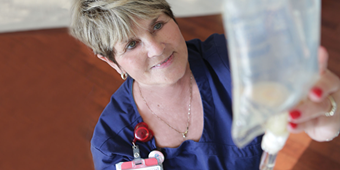A Close-Up Look at Uterine Cancer

Answer a few questions and we'll provide you with a list of primary care providers that best fit your needs.
Your uterus is a defining part of being a woman, whether it causes you the discomfort of monthly cramps or is nurturing a growing baby within you. It can also be a site for cancer to take hold, most commonly after age 50.
The number of cases and deaths due to uterine cancer are increasing across all ethnic groups.
It’s not nearly as prevalent as breast cancer, which strikes more than 300,000 American women each year. Uterine cancer affects far fewer: about 60,000 women annually. It is the fourth most common cancer for women in the U.S. and the most common gynecologic cancer.
This pear-shaped organ in your lower abdomen has three layers. From the outside in, they are:
- Serosa, the outer layer of tissue coating the uterus
- Myometrium, the thick and muscular middle layer
- Endometrium, the inner lining of the uterus
The two different types of uterine cancer are most likely to form in the middle and inner layers.
Another Name for Endometrial Cancer?
 Many people think endometrial cancer and uterine cancer are the same. In truth, there are two main types of uterine cancer and endometrial is the most common:
Many people think endometrial cancer and uterine cancer are the same. In truth, there are two main types of uterine cancer and endometrial is the most common:
Endometrial cancer. This cancer begins in the cells of the endometrium, the inner lining of the uterus. It accounts for about 95 percent of uterine cancers and is caught at an early stage about two-thirds of the time. Many women with uterine cancer notice abnormal vaginal bleeding as an early warning sign. Learn what to watch for.
Uterine sarcoma. A uterine sarcoma is a type of cancer that starts in the myometrium, the muscle layer of the uterus or in the connective tissue that supports the uterus. There are different types of uterine sarcomas, but together they make up less than 5 percent of all uterine cancers.
Your doctors will determine if your cancer is a type that grows fast or slowly. Your treatment will depend on the type of cancer and its stage.
What Causes Uterine Cancer?
No one really knows what causes uterine cancer, although many medical experts believe that too much of the female hormone estrogen may trigger cancer cells to grow in the uterus.
According to the American Cancer Society, the number of cases and deaths due to uterine cancer are increasing across all ethnic groups. Certain risk factors, such as being over age 50 or being obese, may increase your chances of developing cancer.
If you exercise regularly and eat a low-fat diet, it may help you prevent uterine cancer.
Today, there is no routine screening test for uterine cancer, though researchers are studying some possibilities. Staying alert to the warning signs and finding the disease early will give you the best chance for recovery.
Answer a few questions and we'll provide you with a list of primary care providers that best fit your needs.
Source: American Cancer Society; National Cancer Institute; Cancer.Net




